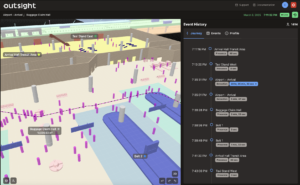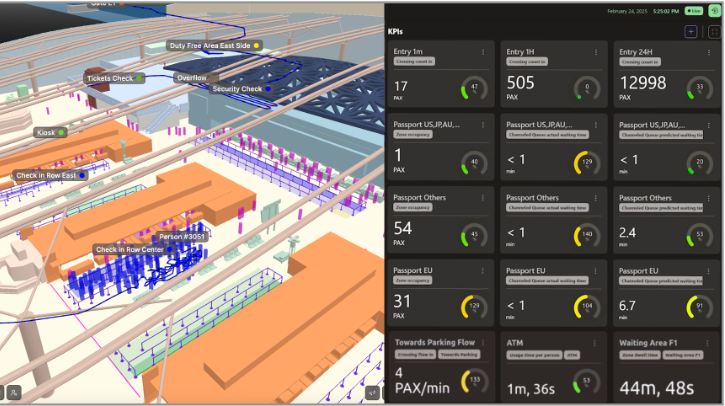Raul Bravo, president and founder of Outsight, discusses the future of passenger journey intelligence in airports.
The aviation industry is experiencing a dynamic growth trajectory, surpassing pre-pandemic levels. With passenger volumes expected to reach 19.5 billion by 2042, according to ACI International, what do you see as the key operational challenges that airports will face in the coming decade?
The projected growth in passenger traffic presents a multi-faceted challenge for airport operators. Beyond handling sheer volume, airports must enhance passenger experience while addressing both sustainability and profitability. Achieving operational efficiency is the key to balancing these competing demands. With many airports nearing full capacity and infrastructure expansion being both costly and lengthy, optimizing existing spaces is critical. Understanding how passengers and vehicles move and interact with available resources is the biggest lever for improving efficiency – not just expanding infrastructure.

This is where a new generation of airport systems – passenger journey intelligence centers (PJIC) – comes into play. A PJIC offers continuous, actionable insights into physical flows, which I believe will become central to airport operations, as the transformative introduction of systems such as AODB and RMS were in the past.
How do you see technology, specifically PJIC systems, reshaping the passenger journey?
Most airport processes – check-in, security screening, baggage handling – are largely digitalized. However, the physical flow of people and vehicles remains notably unoptimized. This is due to its inherent complexity and the lack of appropriate technologies. Digitalizing these flows is, in my opinion, the single most transformative solution currently available to airport operators for improving operational efficiency, passenger satisfaction and safety – both at the curbside and within terminal operations.
A PJIC achieves this by continuously monitoring movement in real time, unlocking new insights and a level of business intelligence that traditional systems cannot provide. It’s not just about where people are or how many of them there are, but how they move, interact within the space, and how they behave – information that was previously, for the most part, a black box for airport operators.
Continuous information seems vital here. Could you explain the importance of continuous tracking throughout the passenger journey?
Absolutely. Legacy solutions provided fragmented insights – monitoring isolated touchpoints like check-in counters or security lines. But what happens between these points? And how can these data points be connected within a consistent reference system that accounts for their spatial nature – not only when things happened but also where and by whom?
That’s where the majority of inefficiencies and potential risks reside, but also where incredible opportunities for improvement can be found.
A PJIC delivers continuous information throughout the entire journey, offering a holistic view of passenger behavior and movement. This enables airports not only to react in real time but also to predict and prevent issues before they arise. The differentiation here is profound: continuous tracking transforms isolated datapoints into comprehensive narratives, rooted in the actual physical world, that drive informed decision-making.
What makes lidar particularly suitable to provide the spatial intelligence required by PJIC systems?
The key lies in lidar’s ability to capture 3D spatial information, which includes two crucial capabilities that were previously not available in a single sensor: the ability to perceive the environment and localize people, vehicles and objects simultaneously.
Unlike cameras that offer only 2D perception without a true understanding of an object’s position, size or velocity, lidar measures distances with centimeter-level accuracy. Moreover, it’s immune to lighting conditions and can be installed in various positions, minimizing the required hardware costs.
Wi-fi-based solutions, on the other hand, offer localization but lack perception capabilities and accuracy. Lidar bridges this gap, providing the comprehensive data needed for a live digital twin – a unified 3D reference system that represents and interacts with the insights gathered from the PJIC.
This live digital twin is a game-changer, as it incorporates the actual dynamic data of the premises, going beyond the traditional notion of a digital twin, which typically focuses on static components such as buildings and equipment. The result is a powerful capability that enables airport operators not only to visualize but also to understand, manage and predict physical flows seamlessly.
Why now? What has changed that makes PJIC systems feasible today?
That’s a critical question. Several technological and societal shifts have converged, making PJIC systems not only possible but essential.
First, lidar sensors have become more affordable and mature, thanks, in part, to high production volumes and advances driven by the automotive industry. We have already seen that without 3D-native sensors like lidar, it’s impossible to fully deliver the capabilities of a PJIC.
Second, the emergence of edge computing technology, combined with cloud infrastructure, now supports the real-time processing of massive 3D datasets, while keeping the advantages of business intelligence accessible via the cloud. Given the huge amounts of data involved, without these efficient techniques, deploying PJIC solutions would not be practical.
Third, the rise of spatial AI techniques and robust software platforms like Outsight’s – adopted by major international airports across five continents – means we can now derive actionable insights at scale. Sensing and processing hardware are essential but not sufficient. Robust and high-performance software solutions are the real unlocking factor.
Additionally, thanks to recent advances in web-based 3D rendering technologies, digital twins are now easily accessible through standard browsers, offering intuitive interfaces that make these insights both interactive and user friendly. Capturing and delivering 3D spatial insights is the most effective application of a native 3D interface like digital twins. Lastly, growing privacy concerns are increasingly steering the industry toward non-intrusive technologies that do not capture images or smartphone data.

Beyond operational efficiency, how does a PJIC contribute to security and sustainability?
A PJIC enhances security through lidar’s dual capabilities – localization and perception – enabling the early detection of anomalies without infringing on privacy.
It also plays a crucial role in sustainability. By optimizing physical flows, airports can reduce energy consumption, streamline resource use and lower carbon footprints. Additionally, predictive maintenance powered by PJIC insights extends equipment lifespan and minimizes waste. All these elements align with global sustainability goals and support operational resilience in modern airport environments.
Looking forward, how do you envision the role of PJIC systems evolving in the airport ecosystem?
I foresee PJIC systems becoming standard in every major airport. They will serve as a key contributor – or even the nerve center – for decision-making, supported by live digital twins that provide real-time, actionable insights alongside advanced predictions.
As passenger volumes grow and operational demands increase, the ability to anticipate and adapt will be the key differentiator. PJIC systems will make this possible, ensuring that airports remain efficient, secure and sustainable hubs in an interconnected world.
Are there any other important topics you believe deserve attention?
Absolutely. While we’ve covered the essential role of PJIC systems in transforming airport operations, there are still several key topics worth discussing. For instance, how PJIC systems can drive personalized passenger experiences through data-driven services, the role of collaboration between airport stakeholders for end-to-end journey optimization, and how PJIC platforms can unlock new revenue opportunities for retail activities and digital advertising.
Additionally, the scalability of these solutions for airports of different sizes and their economic impact are topics we hope to cover in future discussions. We also see exciting opportunities in integrating emerging technologies like 5G, IoT and autonomous systems within the PJIC ecosystem. We’ll delve into these subjects and more in upcoming articles and interviews on our website.
Thank you for your time and insights.
Thank you. It’s been a pleasure discussing how PJIC systems are poised to transform the airport experience for passengers and operators alike.
Outsight demoed its lidar-based software solutions at Passenger Terminal Expo 2023. Click here to watch the full video.
Raul will talk about how lidar-powered intelligence is transforming airport operations on Day 3 (April 10, 2025) of the PTE World Innovation Showcase. Click here for your FREE pass.


